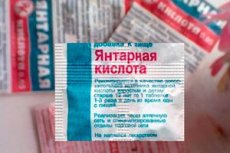Medical expert of the article
New publications
Harm of succinic acid to the human body
Last reviewed: 08.07.2025

All iLive content is medically reviewed or fact checked to ensure as much factual accuracy as possible.
We have strict sourcing guidelines and only link to reputable media sites, academic research institutions and, whenever possible, medically peer reviewed studies. Note that the numbers in parentheses ([1], [2], etc.) are clickable links to these studies.
If you feel that any of our content is inaccurate, out-of-date, or otherwise questionable, please select it and press Ctrl + Enter.

Our body produces and receives at least 200 g of succinic acid daily with food and uses it for normal metabolism and providing cells with energy. However, in many pathological conditions and diseases, this acid is taken in the form of drugs and dietary supplements. Can succinic acid be harmful in such cases?
Extraordinary ordinary succinic acid
Not all organic carboxylic acids are of such interest to biochemists and physicians as 1,4-butanedioic or succinic acid, synthesized by mitochondria of cells – an intermediate product of the Krebs cycle, a substrate and catalyst for biological processes in the body, including the synthesis of ATP, oxidation-reduction reactions, acid-base homeostasis, etc.
Numerous reviews from doctors - cardiologists, endocrinologists, neurologists, immunologists - testify in favor of succinic acid (succinate), which has enormous potential and a range of therapeutic effects: antioxidant, antihypoxic, anti-inflammatory, neuroprotective, anxiolytic, and general tonic.
More detailed information in the material - Preparations with succinic acid
Experiments have shown that succinic acid helps reduce fatigue, increases performance, physical endurance and mental abilities, and accelerates recovery after serious illnesses and operations.
Read about other beneficial properties of succinic acid in this article.
What is the harm of succinic acid?
But, as we know, there are no absolutely harmless drugs. Nevertheless, 40 years ago, the Special Committee on Substance Safety (SCOGS) of the US Food and Drug Administration stated: "there is no evidence that succinic acid is dangerous for humans or animals. In addition, animals on which experiments were conducted tolerate succinic acid in fairly large doses. However, a reasonable average daily dose of succinic acid added to food should not exceed 0.01 mg per kilogram of body weight per day. This is an order of magnitude less than the amount of succinate causing toxic symptoms in experimental animals."
If toxic symptoms were present, does that mean that they could show the harm of succinic acid? And in experimental animals, according to the researchers' reports, gastrointestinal bleeding, diarrhea, lethargy, weight loss; eye damage; erythema and swelling of the skin - here you have the harm of succinic acid for the skin (after all, this is how most simple mono- and dicarboxylic acids manifest themselves).
Indian biologists gave this acid to rats, and 36% of the rodents developed bladder stones after a month. And the results of a study of the effect of succinic acid on the mucous membrane of the large intestine in rats were published in The Journal of Gastroenterology. It turned out that the higher the level of succinic acid in the body, the more intense the formation of erosion of the mucous membrane of the large intestine. It was suggested that damage to the mucous membrane is caused by a decrease in blood flow and infiltration of the mucous membrane by polymorphonuclear cells generating superoxide radicals. As a result, reactive oxygen species led to the development of oxidative stress and cell apoptosis.
Succinic acid is a food additive, but it is very biologically active.
But let's get back to people. The FDA registry (2004) states that succinic acid is a food additive (E363) that regulates the acidity of food products and is permitted for direct addition to them if the amount of the substance does not exceed the reasonable required amounts (6 g per kilogram of product).
Endogenous succinic acid is one of the main catalysts for the degradation of the inhibitory neurotransmitter GABA, therefore, when administered as an exogenous component, it can lead to increased psychomotor agitation. In this case, the harm of succinic acid for children is obvious, if parents give it to them with good intentions, but without a doctor's recommendation. Succinate behaves actively and can provoke not only insomnia, dizziness, increased temperature and diuresis, but also damage to tooth enamel, increased acidity of gastric juice (and, therefore, damage to its mucous membrane); muscle and joint pain; problems with the liver, kidneys and bladder.
Please note the list of contraindications for drugs that contain succinic acid as the main active ingredient. These are gastritis with high acidity and gastric ulcer (and duodenal ulcer); urolithiasis; ischemic heart disease; functional renal failure, etc.
Succinic acid is not transformed into metabolites in the liver: its molecules are partially embedded between the molecules of phospholipid cell membranes. The ability of succinic acid to local interstitial (extracellular) accumulation in damaged and ischemic tissues of the liver, kidneys, brain, as well as in blood plasma has also been identified.
Several years ago, the succinate metabolic receptor GPR91 was classified, which is expressed in the kidneys and binds succinate as a ligand. This can lead to the release of renin by the glomerular apparatus of the renal effector cells and activation of the renin-angiotensin system. This is how succinic acid-induced hypertension develops.
And the accumulation of succinic acid and its compounds in the liver parenchyma (which also has GPR91 receptors) is fraught with the proliferation of connective tissue, that is, fibrosis.
Probably, everyone needs to keep in mind that benefits and harms are antagonists, therefore the harm of succinic acid and its benefits need to be studied, and not absolutized, misleading people who are inclined to believe in a panacea.


 [
[